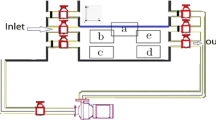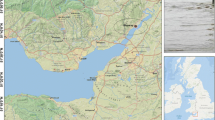Abstract
In order to create natural and healthy water ecosystems, the impact of hydrological processes in ponds must be identified. Pond structure may affect water quality in many ways. The present study provides a novel insight into some of the hydrological processes as well as how to employ retentions to enhance storm water detention and manage discharge. In this research, particle image velocimetry is utilized to study the two-dimensional collecting efficiency of fine sediments by retention structures with a range of hydraulic features. To examine the hydrodynamic behavior of water mixed with fine particles, a sediment basin was designed. Fluorescent polymer particles (1–50 μm) were subsequently added to this fluid mix. This study demonstrates that gravitational force increases fine particle settlement by over 50% at greater depths. The optimum collecting efficiency of sediments at the water surface was found to be around 80%. It was also determined that flow rate and particle size are directly correlated and that inlets and outlets at higher levels impede fine particle dispersion in the water column. For these reasons, it seems that adjusting the hydraulic parameters may diminish siltation.






Similar content being viewed by others
References
Ab Ghani A, Azamathulla HM, Lau TL, Ravikanth C, Zakaria NA, Leow CS, Yusof MAM (2011) Flow pattern and hydraulic performance of the REDAC gross pollutant trap. Flow Meas Instrum 22:215–224
Ahrens JP (2000) A fall-velocity equation. J Waterw Port Coast Ocean Eng 126:99–102
Althaus J, Isabella JM, De Cesare G, Schleiss A (2011) Fine sediment release from a reservoir by controlled hydrodynamic mixing. In: Proceedings of the 34th IAHR World Congress, vol EPFL-CONF-168557. pp 1763–1770
Azamathulla HM, Ghani AA, Fei SY (2012) ANFIS-based approach for predicting sediment transport in clean sewer. Appl Soft Comput 12:1227–1230
Azamathulla HM, Ahmad Z, Ghani AA (2013) An expert system for predicting Manning’s roughness coefficient in open channels by using gene expression programming. Neural Comput Appl 23:1343–1349
Bajcar T, Gosar L, Širok B, Steinman F, Rak G (2010) Influence of flow field on sedimentation efficiency in a circular settling tank with peripheral inflow and central effluent. Chem Eng Process Process Intensif 49:514–522
Bajcar T, Steinman F, Širok B, Prešeren T (2011) Sedimentation efficiency of two continuously operating circular settling tanks with different inlet-and outlet arrangements. Chem Eng J 178:217–224. doi:10.1016/j.cej.2011.10.054
Boyle JF, Manas-Zloczower I, Feke DL (2005) Hydrodynamic analysis of the mechanisms of agglomerate dispersion. Powder Technol 153:127–133
Brethour J, Burnham J (2010) Modeling sediment erosion and deposition with the FLOW-3D sedimentation & scour model flow science. In: Technical Note, FSI-10-TN85, pp 1–22
Cammem L (1982) Effect of particle size on organic content and microbial abundance within four marine sediments. Mar Ecol Progr Ser Oldend 9:273–280
Camnasio E, Orsi E, Schleiss AJ (2011) Experimental study of velocity fields in rectangular shallow reservoirs. J Hydraul Res 49:352–358
Camnasio E, Erpicum S, Orsi E, Pirotton M, Schleiss AJ, Dewals B (2013) Coupling between flow and sediment deposition in rectangular shallow reservoirs. J Hydraul Res 51:535–547
Chen S, Timmons MB, Bisogni JJ Jr, Aneshansley DJ (1993) Suspended-solids removal by foam fractionation. Progr Fish Cultur 55:69–75
Cheng N-S (1997) Simplified settling velocity formula for sediment particle. J Hydraul Eng 123:149–152
Cholette A, Cloutier L (1959) Mixing efficiency determinations for continuous flow systems. Can J Chem Eng 37:105–112
Cripps SJ, Bergheim A (2000) Solids management and removal for intensive land-based aquaculture production systems. Aquac Eng 22:33–56
De Lima PH, Janzen JG, Nepf HM (2015) Flow patterns around two neighboring patches of emergent vegetation and possible implications for deposition and vegetation growth. Environ Fluid Mech 15:881–898
Dufresne M, Dewals BJ, Erpicum S, Archambeau P, Pirotton M (2010a) Classification of flow patterns in rectangular shallow reservoirs. J Hydraul Res 48:197–204
Dufresne M, Dewals BJ, Erpicum S, Archambeau P, Pirotton M (2010b) Experimental investigation of flow pattern and sediment deposition in rectangular shallow reservoirs. Int J Sedim Res 25:258–270
Dufresne M, Dewals BJ, Erpicum S, Archambeau P, Pirotton M (2011) Numerical investigation of flow patterns in rectangular shallow reservoirs. Eng Appl Comput Fluid Mech 5:247–258
Ellis JB, Revitt DM (1982) Incidence of heavy metals in street surface sediments: solubility and grain size studies. Water Air Soil Pollut 17:87–100
Ghani AA, Mohammadpour R (2015) Temporal variation of clear-water scour at compound abutments. Ain Shams Eng J. doi:10.1016/j.asej.2015.07.005
Ginsberg SS, Aliotta S (2011) Sediment transport circulation pattern through mesotidal channels system. INTECH Open Access Publisher, India
Goula AM, Kostoglou M, Karapantsios TD, Zouboulis AI (2008) A CFD methodology for the design of sedimentation tanks in potable water treatment: case study: the influence of a feed flow control baffle. Chem Eng J 140:110–121
Guo J (2002) Logarithmic matching and its applications in computational hydraulics and sediment transport. J Hydraul Res 40:555–565
Hadad T, Gurka R (2013) Effects of particle size, concentration and surface coating on turbulent flow properties obtained using PIV/PTV. Exp Thermal Fluid Sci 45:203–212
Hidayah E, Karnaningroem N (2012) The implementation of hydrodynamic model in water treatment to estimate turbidity removal. Int J Environ Sci Res 2:129–133
Jacobs C, Jendrassak M, Gurka R, Hackett E (2014) Effects of turbulence on settling velocities of synthetic and natural particles. In: AGU fall meeting abstracts
Jakubowski M, Wyczalkowski W, Poreda A (2015) Flow in a symmetrically filled whirlpool: CFD modelling and experimental study based on Particle Image Velocimetry (PIV). J Food Eng 145:64–72
Jamshidnia H, Firoozabadi B (2010) Experimental investigation of Baffle effect on the flow in a rectangular primary sedimentation tank
Karlsson K, Viklander M, Scholes L, Revitt M (2010) Heavy metal concentrations and toxicity in water and sediment from stormwater ponds and sedimentation tanks. J Hazard Mater 178:612–618
Kashani MM, Hin LS, Ibrahim SB, Sulaiman NMBN, Teo FY (2016) An investigation into the effects of particle texture, water content and parallel plates' diameters on rheological behavior of fine sediment. Int J Sedim Res 31:120–130
Kemker C (2014) Sediment transport and deposition. Fondriest Environmental, Inc. http://www.fondriest.com/environmental-measurements/parameters/hydrology/sediment-transport-deposition/. Accessed 10 Oct 2015
Kiat CC, Ab Ghani A, Abdullah R, Zakaria NA (2008) Sediment transport modeling for Kulim River—a case study. J Hydro Environ Res 2:47–59
Lambrechts T, François S, Lutts S, Muñoz-Carpena R, Bielders CL (2014) Impact of plant growth and morphology and of sediment concentration on sediment retention efficiency of vegetative filter strips: flume experiments and VFSMOD modeling. J Hydrol 511:800–810
Levenspiel O (2002) Modeling in chemical engineering. Chem Eng Sci 57:4691–4696
Li Y, Li Y, Xia W, He C, Zhu R (2017) A novel particulate sedimentation model in inclined channels of liquid–solid fluidized bed. Powder Technol 305:764–770
López PR, Lavín AG, López MMM, de las Heras JLB (2008) Flow models for rectangular sedimentation tanks. Chem Eng Process Process Intensif 47:1705–1716
Mackay D (2001) Multimedia environmental models: the fugacity approach. CRC Press, Boca Raton
Marsalek J, Watt W, Anderson B, Jaskot C (1997) Physical and chemical characteristics of sediments from a stormwater management pond. Water Qual Res J Can 32:89–100
Matko T, Fawcett N, Sharp A, Stephenson T (1996) Recent progress in the numerical modelling of wastewater sedimentation tanks. Process Saf Environ Prot 74:245–258
MoayeriKashani M, Hin LS, Ibrahim S, Sulaiman NM (2016) A study on hydrodynamic behavior of fine sediment in retention structure using particle image velocimetry. Water Environ Res 88:2309–2320
Mohammed MA (2017) Studying the factors affecting the settling velocity of solid particles in non-newtonian fluids Al-Nahrain. J Eng Sci 16:41–50
Naegele H-J, Mönch-Tegeder M, Haag NL, Oechsner H (2014) Effect of substrate pretreatment on particle size distribution in a full-scale research biogas plant. Bioresour Technol 172:396–402
Peukert W, Wadenpohl C (2001) Industrial separation of fine particles with difficult dust properties. Powder Technol 118:136–148
Raffel M, Seelhorstt U, Willert C (1998) Vortical flow structures at a helicopter rotor model measured by LDV and PIV The. Aeronaut J 102:221–227
Rosenthal H, Hoffmann R, Jörgensen L, Krüner G, Peters G, Schlotfeldt H, Schomann H (1982) Water management in circular tanks of a commercial intensive culture unit and its effects on water quality and fish condition. In: ICES Statutory meeting, CM
Rostami F, Shahrokhi M, Said MAM, Abdullah R (2011) Numerical modeling on inlet aperture effects on flow pattern in primary settling tanks. Appl Math Model 35:3012–3020
Shahi S, Kuru E (2016) Experimental investigation of the settling velocity of spherical particles in Power-law fluids using particle image shadowgraph technique. Int J Miner Process 153:60–65
Shahidan NF, Hasan ZA, Abdullah MZ, Ghani AA (2012) Mathematical modelling of flow and sediment pattern at Ijok Intake, Ijok River, Perak, Malaysia. Int J Model Simul 32:165
She K, Trim L, Pope D (2005) Fall velocities of natural sediment particles: a simple mathematical presentation of the fall velocity law. J Hydraul Res 43:189–195
Southard J (2006) The sediment transport rate. Massachusetts Institute of Technology, Cambridge
Sperazza M, Moore JN, Hendrix MS (2004) High-resolution particle size analysis of naturally occurring very fine-grained sediment through laser diffractometry. J Sedim Res 74:736–743
Tarpagkou R, Pantokratoras A (2013) CFD methodology for sedimentation tanks: the effect of secondary phase on fluid phase using DPM coupled calculations. Appl Math Model 37:3478–3494
Van Doorne C, Westerweel J (2007) Measurement of laminar, transitional and turbulent pipe flow using stereoscopic-PIV. Exp in Fluids 42:259–279
Wang XL, Li T, Lang J, Zhou SS, Zhang LL, Chen MX (2010) Numerical analysis of solid–liquid two-phase flow on sandstone wastewater of hydropower stations in a rectangular sedimentation tank. Ind Eng Chem Res 49:11714–11723
Westers H (1995) Feed and feeding strategies to reduce aquaculture waste. In: Aquaculture Bioengineering Corporation, Aquaculture Engineering and Waste Management: In Proceeding from the Aquaculture Expo VIII and Aquaculture in the Mid-Atlantic Conference, pp 365–376
Wu B, Chen S (2008) CFD simulation of non-Newtonian fluid flow in anaerobic digesters. Biotechnol Bioeng 99:700–711
Zakaria NA, Azamathulla HM, Chang CK, Ghani AA (2010) Gene expression programming for total bed material load estimation—a case study. Sci Total Environ 408:5078–5085
Zhang W, Zou Z, Sui J (2010) Numerical simulation of a horizontal sedimentation tank considering sludge recirculation. J Environ Sci 22:1534–1538
Zhao J, Zhao Y, Zhao X, Jiang C (2016) Agricultural runoff pollution control by a grassed swales coupled with wetland detention ponds system: a case study in Taihu Basin, China. Environ Sci Pollut Res 23:9093–9104
Zhiyao S, Tingting W, Fumin X, Ruijie L (2008) A simple formula for predicting settling velocity of sediment particles. Water Sci Eng 1:37–43
Zhu L, Cheng N (1993) Settlement of settling particles River and Harbour Engineering Department. Nanjing Hydraulic Research Institute, Nanjing (in Chinese)
Acknowledgements
The authors are grateful to the government of Malaysia for the financial support from university of Malaya through the UMRG Grant No. RP008B-13sus and ministry of higher education (MOHE) through the FRGS grant no. FP028-2012A. The authors also would like to thank faculty of engineering, University of Malaya, for all the facilities provided.
Author information
Authors and Affiliations
Corresponding author
Ethics declarations
Conflict of interest
The authors declare that they have no conflict of interest.
Rights and permissions
About this article
Cite this article
MoayeriKashani, M., Hin, L.S. & Ibrahim, S. Experimental investigation of fine sediment deposition using particle image velocimetry. Environ Earth Sci 76, 655 (2017). https://doi.org/10.1007/s12665-017-7001-2
Received:
Accepted:
Published:
DOI: https://doi.org/10.1007/s12665-017-7001-2




